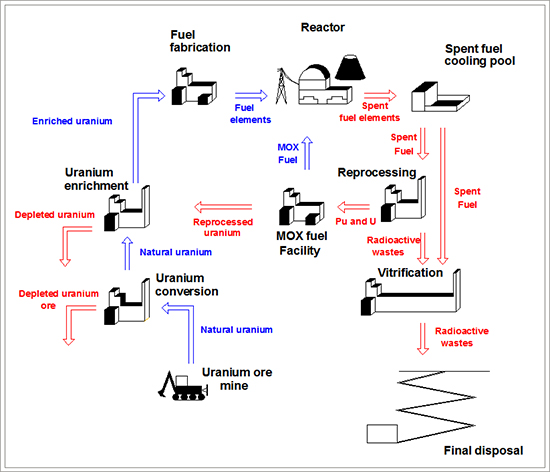
THE ELECTRICITY SUPPLY SYSTEM ASPECT
Problems concerning all sector performance
Fuel cycle : MOX fuel

Source: Own development, based on J. K u b o w s k i "Nowoczesne elektrownie jadrowe", Warszawa, WNT 2010 [19]
During mining extraction, ore of natural uranium is obtained. But in natural ore, there is only 0,6% of fissile U-235 and over 99% of U-238, that can not be directly use in fission reaction. To energy generation of 1 TWh, around 23 tonnes of natural uranium are needed. Meanwhile, in enrichment process, 20 tonnes of depleted uranium is created. In normal once-through cycle such uranium is useless and may by regarded as a waste. In the reactor also only part of fuel loaded to the core is being used. For 2,5 tonnes of uranium in the fuel, only 0,12 tonnes (120 kg) are reactants. The rest is also a long term nuclear waste unless it is transported to chemical reprocessing facility, where without splitting the isotopes, uranium, plutonium, transuranics and other fission products are separated. In that way uranium and plutonium are converted in fresh fuel. Additional fissile plutonium particles ( 65% of 28kg of plutonium from reprocessing) give possibility to generate 0,15 TWh of energy. Fuel using plutonium from wastes reprocessing is called MOX - Metal OXide fuel. Amount of energy gained by MOX fuel use is medium large but undoubtedly useful. Moreover MOX reduces nuclear wastes. The problem with MOX is that 0,15 TWh is not enough to cover cost of MOX production in new chemical reprocessing plants. Fresh uranium fuel is less expensive than MOX. The procedure is cost effective only in case of military spent fuel reprocessing facilities with plutonium technology. [19],[80],[81]
-
Nuclear power industry|
Technology|
The electricity supply system aspect|
Economics|
Environment|
Public aspect|
Future|
Legislation|
References|

